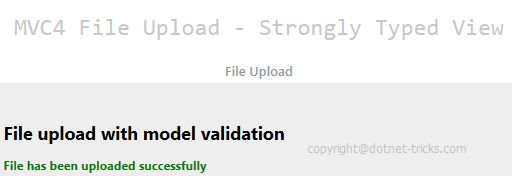mvc自定义上传控件错误异常提示
Many times, we required to upload file with strongly-typed view and also apply validation on uploading file using data annotation validators. In this article, I would like to share, how can we upload a file and validate that file, firstly at client side and after that at server side.
How to do it..
Step 1 : Designing model with data annotation validation
- public class RegistrationModel
- {
- [Required(ErrorMessage = "Please Enter Your Full Name")]
- [Display(Name = "Full Name")]
- public string Name { get; set; }
- [Required(ErrorMessage = "Please Enter Address")]
- [Display(Name = "Address")]
- [MaxLength(200)]
- public string Address { get; set; }
- [Required(ErrorMessage = "Please Upload File")]
- [Display(Name = "Upload File")]
- [ValidateFile]
- public HttpPostedFileBase file { get; set; }
- }
- //Customized data annotation validator for uploading file
- public class ValidateFileAttribute : ValidationAttribute
- {
- public override bool IsValid(object value)
- {
- int MaxContentLength = 1024 * 1024 * 3; //3 MB
- string[] AllowedFileExtensions = new string[] { ".jpg", ".gif", ".png", ".pdf" };
- var file = value as HttpPostedFileBase;
- if (file == null)
- return false;
- else if (!AllowedFileExtensions.Contains(file.FileName.Substring(file.FileName.LastIndexOf('.'))))
- {
- ErrorMessage = "Please upload Your Photo of type: " + string.Join(", ", AllowedFileExtensions);
- return false;
- }
- else if (file.ContentLength > MaxContentLength)
- {
- ErrorMessage = "Your Photo is too large, maximum allowed size is : " + (MaxContentLength / 1024).ToString() + "MB";
- return false;
- }
- else
- return true;
- }
- }
Step 2 : Designing view based on model
- <h2>File upload with model validation</h2>
- <h3 style="color: green">@ViewBag.Message</h3>
- @using (Html.BeginForm("FileUpload", "Home", FormMethod.Post, new { enctype = "multipart/form-data" }))
- {
- <fieldset>
- <legend></legend>
- <ol>
- <li>
- @Html.LabelFor(m => m.Name)
- @Html.TextBoxFor(m => m.Name, new { maxlength = 50 })
- @Html.ValidationMessageFor(m => m.Name)
- </li>
- <li>
- @Html.LabelFor(m => m.Address)
- @Html.TextAreaFor(m => m.Address, new { maxlength = 200 })
- @Html.ValidationMessageFor(m => m.Address)
- </li>
- <li class="lifile">
- @Html.TextBoxFor(m => m.file, new { type = "file" })
- @Html.ValidationMessageFor(m => m.file)
- </li>
- </ol>
- <input type="submit" value="Submit" />
- </fieldset>
- }
Step 3 : Applying jQuery validation for validating file
- <script type="text/jscript">
- //get file size
- function GetFileSize(fileid) {
- try {
- var fileSize = 0;
- //for IE
- if ($.browser.msie) {
- //before making an object of ActiveXObject,
- //please make sure ActiveX is enabled in your IE browser
- var objFSO = new ActiveXObject("Scripting.FileSystemObject"); var filePath = $("#" + fileid)[0].value;
- var objFile = objFSO.getFile(filePath);
- var fileSize = objFile.size; //size in kb
- fileSize = fileSize / 1048576; //size in mb
- }
- //for FF, Safari, Opeara and Others
- else {
- fileSize = $("#" + fileid)[0].files[0].size //size in kb
- fileSize = fileSize / 1048576; //size in mb
- }
- return fileSize;
- }
- catch (e) {
- alert("Error is :" + e);
- }
- }
- //get file path from client system
- function getNameFromPath(strFilepath) {
- var objRE = new RegExp(/([^\/\\]+)$/);
- var strName = objRE.exec(strFilepath);
- if (strName == null) {
- return null;
- }
- else {
- return strName[0];
- }
- }
- $(function () {
- $("#file").change(function () {
- var file = getNameFromPath($(this).val());
- if (file != null) {
- var extension = file.substr((file.lastIndexOf('.') + 1));
- switch (extension) {
- case 'jpg':
- case 'png':
- case 'gif':
- case 'pdf':
- flag = true;
- break;
- default:
- flag = false;
- }
- }
- if (flag == false) {
- $(".lifile > span").text("You can upload only jpg,png,gif,pdf extension file");
- return false;
- }
- else {
- var size = GetFileSize('file');
- if (size > 3) {
- $(".lifile > span").text("You can upload file up to 3 MB");
- }
- else {
- $(".lifile > span").text("");
- }
- }
- });
- });
- </script>
Step 4 : Designing Controller
- public ActionResult FileUpload()
- {
- return View();
- }
- [HttpPost]
- public ActionResult FileUpload(RegistrationModel mRegister)
- {
- //Check server side validation using data annotation
- if (ModelState.IsValid)
- {
- //TO:DO
- var fileName = Path.GetFileName(mRegister.file.FileName);
- var path = Path.Combine(Server.MapPath("~/Content/Upload"), fileName);
- mRegister.file.SaveAs(path);
- ViewBag.Message = "File has been uploaded successfully";
- ModelState.Clear();
- }
- return View();
- }
How it works...
